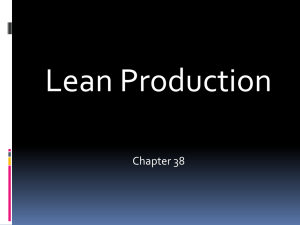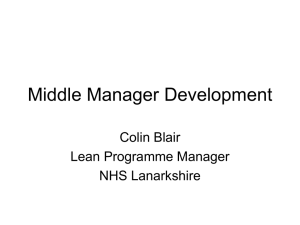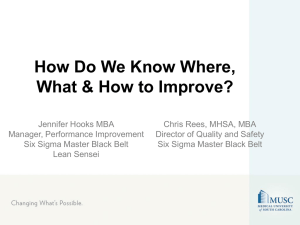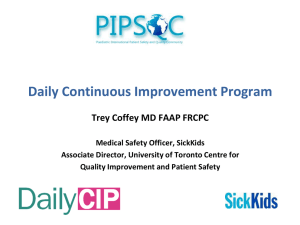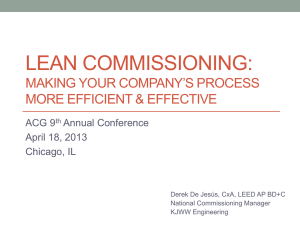slides - University of Central Lancashire
advertisement
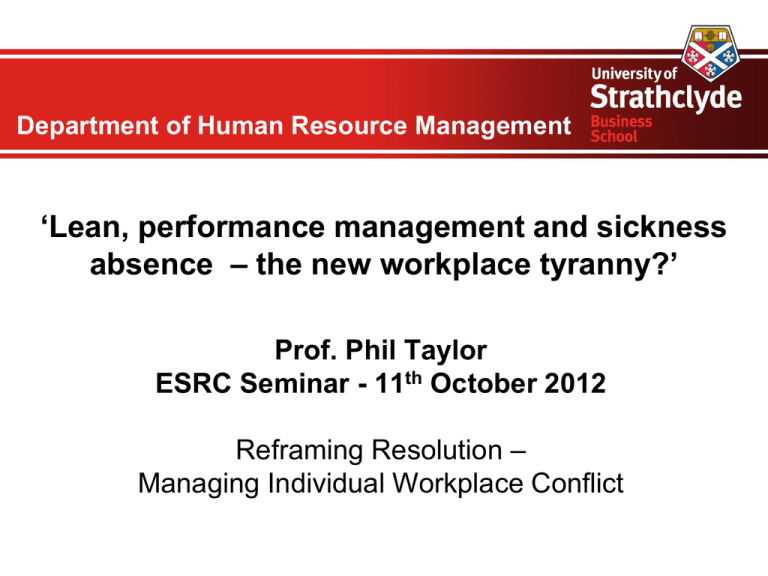
Department of Human Resource Management ‘Lean, performance management and sickness absence – the new workplace tyranny?’ Prof. Phil Taylor ESRC Seminar - 11th October 2012 Reframing Resolution – Managing Individual Workplace Conflict Department of Human Resource Management Introduction • Parallel with the ConDems’ erosion of worker rights… • …a managerial ‘offensive’ on the front-line of work as workers are pushed ever more onto the defensive • Certainly giving rise to ‘conflict’ and to ‘disputes’ but raises the question of the nature of ‘resolution’ • This offensive has at three elements – Lean, Performance Management, Sickness Absence Management – often integrated • Synthesis of evidence from continuous and diverse research projects – suggests sectoral convergence Department of Human Resource Management Employers’ Cost Reduction Strategies STAR Outsourcing/ Offshoring Terms and Conditions Automation Work Intensification, Lean, PM and SAP Department of Human Resource Management Lean, Performance Management and Work Intensification • Most important from the perspective of unions, their members - the ‘survivors’ of the job cull • Integrated managerial offensive that is squeezing increasing amounts of effort out of workers • Cost-cutting strategies being translated into an unprecedented intensification of work • Restructuring, re-engineering ,‘lean’, creative synergies • Equivalent or larger volumes of work being done with the same or - more likely - smaller workforces • Sheer intensity of labour during working shifts Department of Human Resource Management 1) Lean Working • Core thesis – organisations which strip out waste gain significant quality and efficiency advantages = Toyota • Multi-skilling, task enlargement, worker participation in kaizen (Womack et al, 1990) • Lean – counter-posed to Taylorism - removes mindnumbing stress with ‘creative stress’, participation etc. • Hence ‘work smarter, not harder’ mantra • Yet workers’ experiences in autos (Stewart et al, 2008) - tighter supervisory control - narrow tasking - job stress - managerial bullying - lack of voice • Consultant/academics applying lean efficiency savings to public sector, FS, NHS etc. (Radnor, 2010) Department of Human Resource Management • In HMRC has created a brutal form of Taylorism (Carter et al, 2011) • After Lean 95% say work ‘very’/‘quite’ pressurised • Pressure increased ‘a great deal’ – 76% ‘After 27 years in the Inland Revenue following the introduction of lean, I am now deskilled, de-motivated [and] stressed-out most days, afraid to be sick, feel unappreciated, provide a poor service for customers, am not allowed to voice my opinion, looking forward to the day I can leave for good’. (HMRC Worker, Cardiff) • Statistical relationship between work intensity, time at work station, coming to work ill and frequency of symptoms (Carter et al, 2012) Department of Human Resource Management Ill-health Symptoms and Time at Work Station Mental fatigue*** Physical tiredness*** Stiff shoulders Stiff neck** Stress** Backache Headaches Pain/numbness in arms/wrists* Eyesight problems* Blocked nose** Time at work station <85% 85-95% >95% Daily/several times a week 47 42 62 45 43 62 28 38 45 29 38 47 31 33 42 25 32 44 21 26 33 17 24 31 15 19 29 5.0 15 22 Department of Human Resource Management 2) Performance Management • Measurement of performance central to management • Aligning individual with organisational objectives • HRM gives an Orwellian account - ‘Agreed’, ‘shared’, ‘mutual expectations’, ‘dialogue’, ‘support’, ‘guidance’ • Performance Appraisal perhaps an ‘annual ritual’ • Questionable link between effort and reward • PAs annual, 6-monthly – always subjectivity problem • PM now not periodic and retrospective, but continuous, forward looking and shift to disciplinary purpose • Performance Improvement, PIPs, Managing Performance, PIMs, IIPs – the real bite in PM Department of Human Resource Management • Micro-measurement and micro-management of individual performance – facilitated by technologies • Quantitative outputs and targets • KPIs, SLAs – determined at the top, ‘cascade down’ through tiers of managers, to TLs and then workers • Removing the discretion of the FLM – tight links in the chain of command – ‘nothing to do with me’ • Managers themselves given targets for the numbers of ‘managed exits’, underperformers, SAP actions etc. • What is bullying? 1-1 relationships or systemic? • Even the so-called measurables are ‘pseudo-science’ - parameters and definitions set by management • Subjectivity of so-called objective criteria Department of Human Resource Management The 6 Stages of Performance Management 1. First Day at Work You Listen to Sweet Soul Music Everything is Wonderful Department of Human Resource Management Department of Human Resource Management The 6 Stages of Performance Management 2. After 3 Months- Targets Get Hiked Up You Listen to Motörhead You Have No idea If You Are Coming or Going Department of Human Resource Management Department of Human Resource Management The 6 Stages of Performance Management 3. After 9 Months – You Are An Underperformer You Listen to Napalm Death Your Day Starts at 8:00 and Ends at 20.00 You Go Mental Department of Human Resource Management Department of Human Resource Management The 6 Stages of Performance Management 4. After 12 Months – You Are Put on a PIP You Listen to Hip Hop Your Are Passive/Aggressive Most of the Time You Put on Weight – You Are Stressed Department of Human Resource Management Department of Human Resource Management The 6 Stages of Performance Management 5. After 15 Months – You Are Given a Warning You Listen to Gangsta Rap Your Have Seriously Considered Gunning Down Your Team Leaders You Fall From Bed Every Day You Live on Chips and Caffeine Department of Human Resource Management Department of Human Resource Management The 6 Stages of Performance Management 6. After 18 Months – You Listen to LMFAO You Have Totally Lost It Department of Human Resource Management Department of Human Resource Management • Qualitative behaviours and attitudes • In one FS organisation 13 different behaviours ‘delight the customer’, ‘speaks up’, ‘shares ideas’ • ‘Do what is right for the customer, community and organisation, putting aside own agenda’ • ‘Act like the owners of the business…’ • Quantitative measures strictly imposed • Evidence from FS and telecoms that targets first systemically used in contact centres then spread… • HMRC– 6 tax cases an hour, 80 for opening letters • BT engineers – tightly timed jobs, monitoring • Universities – workload models, ‘dashboards’, REF Department of Human Resource Management The Performance Management Bell Curve Meets expectations Below expectations Above expectations Excellent performance Serious under performance 10% 15% 50% 15% 10% Department of Human Resource Management Department of Human Resource Management • Widespread discontent and conflict but perhaps not formal ‘grievance’ over rankings or ratings • Changed criteria -1s and 2s both underperformers • ‘Round table process’, ‘calibration’ or ‘grandparenting’ – to prevent FLMs inflating scores – fixed pot of money • Bank branch of five – 1 placed in each category • Speed of managing people out - 12 weeks, 6 weeks • Gender, age, disability • Scale of intimidation – in one bank 10% on actions • Excellent in all categories but one and then PIP’ed • Sinister practices such as the ‘car park conversation’ • War for Talent (Michaels et al, 2010) – get rid of 10% Department of Human Resource Management ‘There was quite a sinister practice that we were to use – the car-park conversation. A manager would be expected to take an employee, who had received poor performance score, outside for an informal discussion. The manager would then start a conversation along the lines of, ‘You know your last review. It’s only going one way, isn’t it? You should perhaps think about coming to an arrangement’. It was important that the manager would never make any explicit suggestion that the worker should leave. We were given training in how to conduct these conversations; a one-day course on employee relations for HR managers, where we would go through the best mechanisms for ensuring that an employee would voluntarily suggest a compromise agreement’. Department of Human Resource Management Sickness Absence Management • Public discourse that malingering is endemic in ‘sick note Britain’, swinging the lead’ or ‘duvet days’ ‘At a direct cost of £17bn, absence remains a significant burden on the UK economy…particular concern in the public sector, where absence levels remain substantially higher (CBI, 2011) • Focus on - short-term absences – associated with ‘sickies’ + long-term sickness • Aim to reduce sickness absence to acceptable (i.e. negligible) levels • Raft of prescriptive measures introduced for when workers go sick plus metrics, scores and triggers • Bradford factor – penalises short-term sickness, gender Department of Human Resource Management • Yet, sickness absence historically low – 8.5 days in 1998 and 6.5 days in 2011 (CBI) • ‘Sickies’ linked to weekends/sport is largely myth Public sector explained by age, gender etc. (HSE) • Presenteeism a main trend and problem (CIPD, 2012) • Strict sickness absence policies and practices • Studies over 15 years show increase in coming to work when ill, because of SAP, fearful of discipline • Exacerbates the problem (Taylor et al, 2010) • Glasgow City Council study – Unison reps spend 46% of time on cases - counterproductive Department of Human Resource Management Conclusion • Employer strategies using punitive PM and SAPs are short-termist and counter-productive • Enormous commitment of managerial time/resource • The Bell curve should be rejected as inapplicable to employee performance – in principle and practice • Potentially discriminatory – DDA, Equality and Age • Union proactivity in challenging unfair rankings • H&S and stress audits at work should be implemented • Opposition to Beecroft, protected conversations and erosion of employment rights • Public exposure of the worst cases of ‘new tyranny in the contemporary workplace’ – name and shame • What about non-unionised workplaces – 26% density Department of Human Resource Management References Carter, R., Danford, A., Howcroft, D., Richardson, H., Smith, A. and Taylor, P. (2011) ‘”All they lack is a chain”: lean and the new performance management in the British civil service’, New Technology, Work and Employment, 26.2; 83-97 Carter et al, 2012) Radnor, Z. (2010) ‘Transferring lean into government’ Journal of Manufacturing Technology Management, 21:411-428 Stewart, P. et al (2008) “We sell out time no more”: workers’ struggles against lean production in the British car industry, London: Pluto Taylor, P., Cunningham, I., Newsome, K. and Scholarios, D. (2010) ‘”Too scared to go sick” – reformulating the research agenda on sickness absence’, Industrial Relations Journal, 41(4):270-288 Womack, J.D., Jones, D.T. and Roos, D. (1990) The Machine that Changed the World: The Triumph of Lean Production, New York: Rawson Macmillan Department of Human Resource Management The Vicious Circle Intensification of work & insecurity Mental ill-health Contributes to illness Increases insecurity & likelihood of disciplinary Coming to work when ill SAP PM & so-called underperformance Makes condition worse



